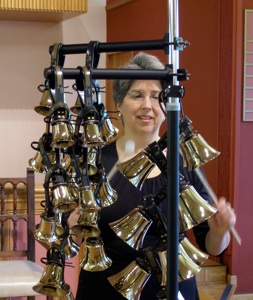I’ve been thinking lately about what makes a good solo piece for a beginner, especially a first solo. I see many handbell soloists dive into repertoire too quickly and ambitiously. It’s time well spent to solidify skills and do choreography exercises before applying them to a performance piece, and to perform simple pieces before tackling hard ones. I’ve developed some choreography exercises that you will find here: Choreography exercises. When picking a performance piece, I suggest using published repertoire at first. There will be plenty of time later to develop your own arrangements, which adds a level of complexity to the task. Continue reading Elements of a good first solo
Category Archives: Getting started
Bell trees: basics
Bell trees were discovered by Louise Frier in the 1980s. As she tells the story, she was working with mallets and also noticed handbell musicians carrying bells from their cases to the bell table by “treeing them up” (looping the handles through others to create a strand, like crocheting, or braiding a sailboat line). In one of those Aha! moments that herald innovation, she put the two ideas together and began malleting bells in trees. Over time, repertoire developed, not only bell tree parts in choir pieces, but works entirely for bell tree soloists. Continue reading Bell trees: basics
Getting started as a soloist – repertoire
When you consider the number of hours that go into learning a handbell solo, and that even the most advanced soloists may have a repertoire of fewer than 100 pieces, you can see the need to choose each piece very carefully. It’s fine to choose your favorite hymn or song as your first piece, but after that you need a strategy for repertoire selection. You want your future concert pieces to have something more in common than that they’re being played on handbells. Every piece needs to be one you truly love, because you’re going to play it literally hundreds of times as you learn it. Continue reading Getting started as a soloist – repertoire
Getting started as a soloist – skills
Before you launch into learning your first solo piece, take the time to develop good technique. Plan to spend time on drills at every practice session; you want to form good habits from the beginning. The basic skills you’ll need immediately are changing bells, table damping, weaving, four-in-hand (ring and knock), Shelley, and an understanding of which hand to use to start a passage. If you don’t know how to do some of them, maybe you’re not ready to start solo ringing. You would be better off finding a quartet to ring with; small ensemble experience is an ideal way to transition from choir ringing to solo ringing. Continue reading Getting started as a soloist – skills
Finding a solo handbell coach
Whether starting to solo or learning specific techniques, look for a teacher. Finding a handbell instructor in your area may prove difficult, and you may need to travel. (While books and videos will be helpful resources, you really need a teacher. Would you try to learn the violin with only a book to guide you? ) Maybe your handbell director can help, or an advanced ringer in your bell choir. Look online for soloists who may live near you, or who travel. If there’s a community bell choir nearby, call and ask if they offer workshops, or if someone in the choir would meet with you to teach you the skills you need. Always check out the prospective coach’s work to see if s/he seems qualified to teach others.
Note: I’m always happy to give advice or feedback on videos, and I also coach soloists remotely using online video chat. Please let me know if I can help you.
